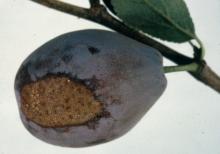See:
Apple (Malus spp.) - Fruit Russeting
Cause Rain during full bloom and for 1 week after (russet scab); high wind for several days within 3 weeks of full bloom (wind scab); or applications of fixed copper have been associated with a russeting of French prunes. Keeping blossoms wet with water for several days at full bloom and petal fall has induced russet scab. No fungal or other microorganisms have been associated with the problem even though fungicides can control the problem. However, a yeast has been associated with russet of pome fruit.
Russeted areas have a thin cuticle, lack epicuticular wax, and have abnormal stomata. Wind scab can occur when immature fruits rub against other fruit, leaves, or stems during strong winds. Fungal rots, such as Diaporthe cinerascens (formerly Phomopsis cinerascens), also may be more a problem at the margin of scabby areas Thrips damage also can result in similar russeting of all stone fruits.
Symptoms Russet scab starts on immature fruit as shiny areas 3 to 4 weeks after full bloom. Four weeks later, these areas become distinct and form an irregular, lacy band generally on the lower half of the fruit. This area becomes brown and rough just before harvest. Scabby areas can remain even after fruit are dried.
Wind scab is similar but generally runs along the axis of the fruit and occurs in the middle of the fruit. It also is a problem after fruit are dried. Similar russeting has been reported on Italian prunes in Oregon, and those affected fruit also are misshapen.
Cultural control Correct pruning for strong limbs will help with wind scab.
Chemical control Apply at full bloom for russet scab when wet weather is forecasted (fungicides would not be helpful for wind or thrips caused russeting).
- Bonide Captan 50 WP at 1 to 1.5 Tbsp/gal water can be used in home gardens. Washington only. H
- Bravo Weather Stik at 3.1 to 4.1 pints/A. Group M5 fungicide. 12-hr reentry.
- Captan 80 WDG at 2.5 to 3.75 lb/A. Group M4 fungicide. 24-hr reentry.
- Echo 720 at 3.1 to 4.1 pints/A. Do not apply after shuck split. Group M5 fungicide. 12-hr reentry.
- Control thrips. See the PNW Insect Management Handbook for details.
Reference Michailides, T.J. 1991. Russeting and russet scab of prune, an environmentally induced fruit disorder: symptomology, induction, and control. Plant Disease 75:1114-1123.

